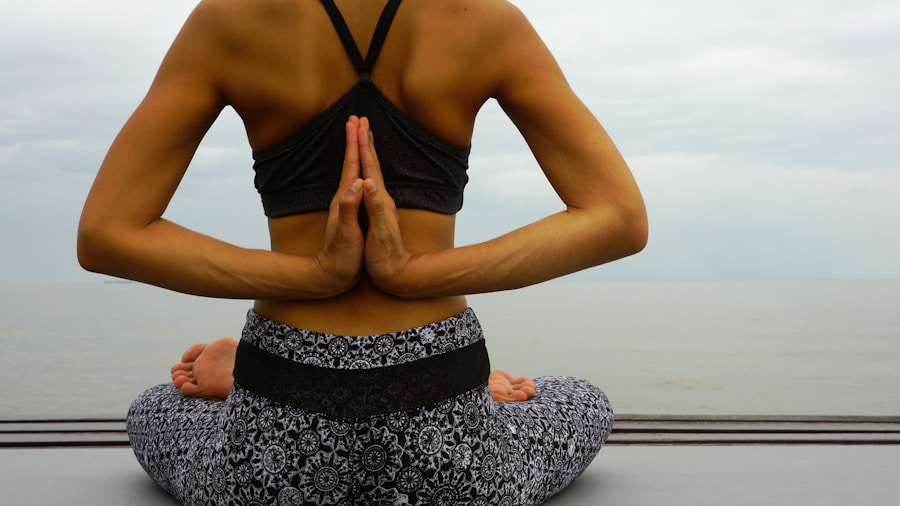Yoga is a multifaceted practice that offers a plethora of physical benefits, making it an appealing choice for individuals seeking to enhance their overall health. One of the most notable advantages of yoga is its ability to improve flexibility. Many yoga poses, or asanas, require the body to stretch and elongate, which can lead to increased range of motion in the joints and muscles.
For instance, poses like Downward Dog and Cobra not only stretch the spine but also engage various muscle groups, promoting a more supple body. Over time, practitioners often find that they can perform movements with greater ease and less discomfort, which is particularly beneficial for those who may have sedentary lifestyles or suffer from stiffness due to age or injury. In addition to flexibility, yoga significantly contributes to strength building.
Many yoga poses require the body to support its own weight, which can lead to increased muscle tone and endurance. For example, poses such as Plank and Warrior II engage multiple muscle groups simultaneously, fostering both stability and strength. This is particularly advantageous for individuals who may not have access to traditional weight training equipment or prefer a more holistic approach to fitness.
Furthermore, the emphasis on core strength in many yoga practices helps to stabilize the body, which can improve posture and reduce the risk of injury in daily activities.
Key Takeaways
- Yoga can improve flexibility and strength through regular practice of various poses and movements.
- Yoga has mental and emotional benefits, such as reducing anxiety and improving mood, through mindfulness and meditation.
- Yoga is important for stress management as it helps to lower cortisol levels and promote relaxation.
- Yoga can improve breathing and circulation through specific breathing techniques and movements that increase blood flow.
- Incorporating yoga into a holistic health routine can lead to overall physical, mental, and emotional well-being.
The Mental and Emotional Benefits of Yoga
Beyond the physical realm, yoga offers profound mental and emotional benefits that can enhance overall well-being. One of the most significant aspects of yoga is its ability to promote mindfulness. Through the practice of focusing on breath and body awareness, individuals can cultivate a deeper connection to their thoughts and feelings.
Research has shown that regular yoga practice can lead to reductions in anxiety and depression, as it encourages individuals to be present in the moment rather than ruminating on past events or worrying about the future. Moreover, yoga serves as a powerful tool for emotional regulation.
The practice encourages individuals to explore their emotions through movement and breath, creating a safe space for self-expression. For instance, restorative yoga poses can evoke feelings of relaxation and safety, allowing practitioners to release pent-up emotions that may have been suppressed. This emotional release can lead to a greater sense of peace and acceptance, as individuals learn to navigate their feelings with compassion rather than resistance.
The integration of meditation into many yoga practices further enhances this emotional awareness, providing practitioners with techniques to manage their thoughts and feelings more effectively.
The Importance of Yoga for Stress Management

In today’s fast-paced world, stress has become a common experience for many individuals. Yoga offers a holistic approach to stress management by addressing both the mind and body. The practice encourages relaxation through deep breathing techniques and gentle movements that activate the parasympathetic nervous system—the body’s natural relaxation response.
This physiological shift can lead to lower heart rates and reduced levels of cortisol, the stress hormone, ultimately promoting a sense of calm and well-being. Additionally, yoga provides practitioners with coping strategies for dealing with stressors in their lives. By cultivating mindfulness through yoga, individuals can develop a greater awareness of their stress triggers and learn how to respond rather than react impulsively.
Techniques such as Ujjayi breath or alternate nostril breathing can be particularly effective in grounding oneself during challenging situations. As practitioners become more adept at managing their stress responses through yoga, they often find that they are better equipped to handle life’s challenges with resilience and grace.
How Yoga Can Improve Flexibility and Strength
The relationship between flexibility and strength is intricate, with each aspect complementing the other in the practice of yoga. As individuals engage in various asanas, they not only stretch their muscles but also build strength in those very areas. For instance, poses like Triangle Pose require both flexibility in the hips and strength in the legs and core to maintain balance and alignment.
This dual focus on flexibility and strength is what makes yoga a unique form of exercise that transcends traditional fitness modalities. Moreover, improved flexibility gained from regular yoga practice can enhance athletic performance in other sports or physical activities. Athletes often incorporate yoga into their training regimens to prevent injuries caused by tight muscles or imbalances.
For example, runners may benefit from poses that target the hip flexors and hamstrings, which are commonly tight due to repetitive motion. By increasing flexibility in these areas, athletes can improve their range of motion and overall performance while reducing the risk of strains or sprains.
Yoga’s Role in Improving Breathing and Circulation
Breathing is a fundamental aspect of yoga that is often overlooked but plays a crucial role in enhancing overall health. The practice emphasizes deep, conscious breathing techniques known as pranayama, which can significantly improve lung capacity and respiratory function. By focusing on breath control during yoga sessions, practitioners learn to engage their diaphragm fully, leading to more efficient oxygen exchange in the body.
This not only supports physical activity but also promotes relaxation by activating the body’s natural calming response. In addition to improving breathing, yoga also enhances circulation throughout the body. Many yoga poses encourage blood flow by promoting movement in various muscle groups and stimulating the cardiovascular system.
For instance, inversions like Shoulder Stand or Headstand can increase blood flow to the brain while also aiding in venous return from the lower extremities. Improved circulation can lead to better nutrient delivery to cells and enhanced detoxification processes within the body. As a result, practitioners often report feeling more energized and revitalized after their yoga sessions.
Incorporating Yoga into a Holistic Health Routine

Integrating yoga into a holistic health routine can create a synergistic effect that enhances overall well-being. A holistic approach considers not only physical fitness but also mental, emotional, and spiritual health. By incorporating yoga into daily life, individuals can create a balanced routine that addresses multiple aspects of health simultaneously.
For example, combining yoga with nutritious eating habits and adequate sleep can amplify the benefits of each component, leading to improved energy levels and vitality. Furthermore, establishing a consistent yoga practice can serve as a foundation for other healthy habits. Many practitioners find that as they become more attuned to their bodies through yoga, they are more inclined to make mindful choices regarding nutrition and lifestyle.
This might include opting for whole foods over processed options or prioritizing self-care activities such as meditation or journaling. By viewing health through a holistic lens, individuals can cultivate a deeper understanding of their bodies’ needs and develop sustainable practices that support long-term wellness. In conclusion, the multifaceted benefits of yoga extend far beyond mere physical fitness; they encompass mental clarity, emotional resilience, stress management techniques, improved flexibility and strength, enhanced breathing and circulation, and integration into a holistic health routine.
As more individuals discover these benefits, yoga continues to grow in popularity as a transformative practice that nurtures both body and mind.
Yoga is not only beneficial for physical health but also for mental well-being. In fact, practicing yoga can help improve cognitive function and reduce stress levels. According to a related article on the development of rationalism by Descartes, Spinoza, and Leibniz, the practice of yoga can also enhance one’s ability to think critically and make rational decisions. By incorporating yoga into your daily routine, you can not only improve your physical health but also boost your mental clarity and overall well-being. To learn more about the benefits of yoga and how it can improve cognitive function, check out the article here.
FAQs
What are the health benefits of yoga?
Yoga has numerous health benefits, including improved flexibility, strength, and posture, as well as stress reduction and relaxation. It can also help with managing chronic conditions such as high blood pressure, heart disease, and anxiety.
How does yoga contribute to good mental health?
Yoga promotes mental well-being by reducing stress, anxiety, and depression. It also helps improve concentration, focus, and mindfulness, leading to a calmer and more balanced state of mind.
Can yoga help with physical fitness?
Yes, yoga can improve physical fitness by increasing strength, flexibility, and balance. It also helps with weight management and can be a great complement to other forms of exercise.
Is yoga suitable for all ages and fitness levels?
Yoga can be adapted to suit people of all ages and fitness levels. There are various styles and levels of yoga, making it accessible to beginners as well as experienced practitioners.
How often should one practice yoga for optimal health benefits?
For optimal health benefits, it is recommended to practice yoga at least 2-3 times per week. Consistency is key, and even a short daily practice can yield positive results.






















+ There are no comments
Add yours